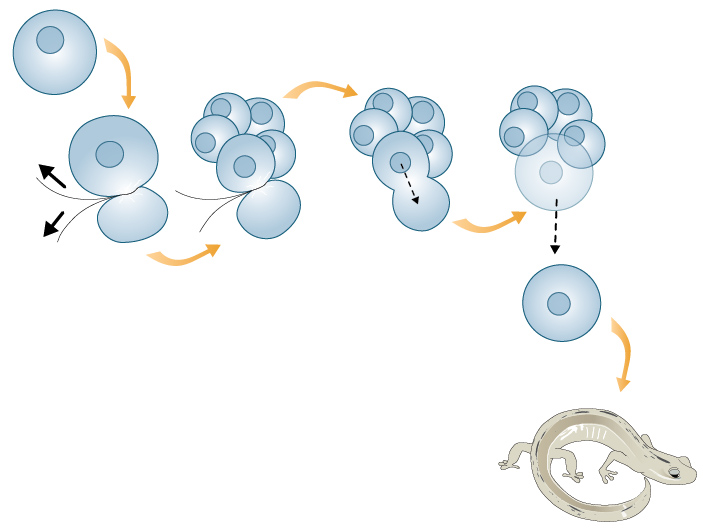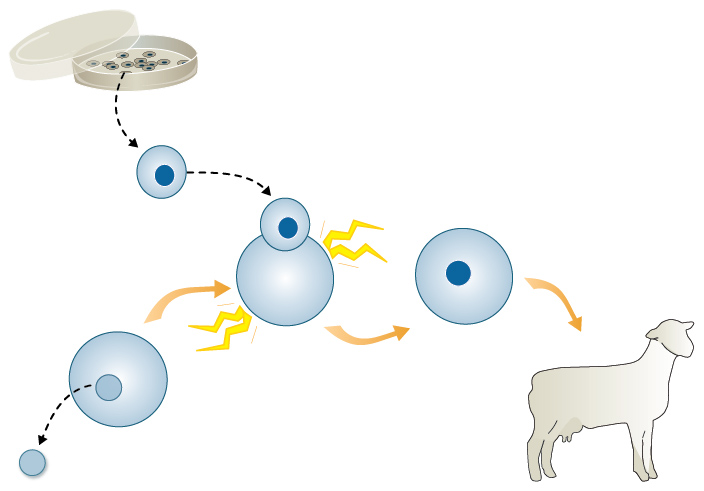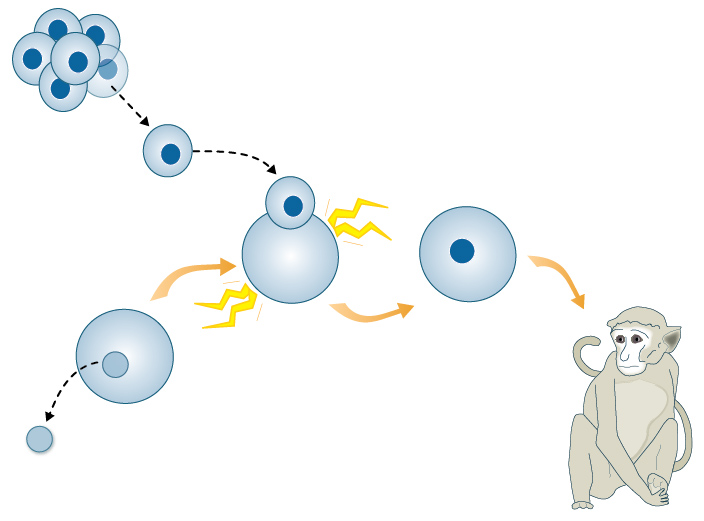Cloning history and features 14th November 2021 – Tags: cloning, cloning history, cloning history and features
Cloning history and features
Introduction
The history of cloning and its characteristics have evolved over time, advancing and giving rise to modern cloning, in this article we will review its evolution and how it is currently applied.
Cloning is a technique used by scientists to make exact genetic copies of living beings. Genes, cells, tissues and even whole animals can be cloned..
In humans, identical twins are similar to clones. They share almost exactly the same genes. Identical twins are created when a fertilised egg splits in two.
Cloning is the process of taking genetic information from a living being and creating identical copies of it. The copied material is called a clone. Geneticists have cloned cells, tissues, genes and entire animals.
Although this process may seem futuristic, nature has been doing it for millions of years. For example, identical twins have nearly identical DNA, and asexual reproduction in some plants and organisms can produce genetically identical offspring. And scientists make genetic doubles in the laboratory, although the process is a little different.
The first cloning study took place in 1885, when German scientist Hans Adolf Eduard Driesch began researching reproduction. In 1902, he succeeded in creating a set of twin salamanders by dividing one embryo into two separate, viable embryos, according to the Genetic Sciences Learning Centre. Since then, there have been many advances in cloning.
How does cloning work?
Cloning is the process of producing individual organisms with identical or virtually identical DNA, either by natural or artificial means.
In the field of biotechnology, Cloning is the process of creating cloned organisms (copies) of cells and DNA fragments (molecular cloning).
There are three different types of cloning, according to the National Human Genome Research Institute (NHGRI):
- Gene cloning, also called DNA cloning, creates copies of genes, or segments of DNA.
- Reproductive cloning creates duplicates of whole animals.
- Therapeutic cloning creates embryonic stem cells, which are used to create tissues that can repair or replace damaged tissue.
History of cloning
The first cloning study took place in 1885, when German scientist Hans Adolf Eduard Driesch began researching reproduction. In 1902, he succeeded in creating a set of twin salamanders by dividing one embryo into two separate, viable embryos, according to the Genetic Sciences Learning Centre. Since then, there have been many advances in cloning.
In 1958, British biologist John Gurdon cloned frogs from the skin cells of adult frogs. On 5 July 1996, a female sheep gave birth to the now famous Dolly, a Finn Dorset lamb – the first mammal cloned from the cells of an adult animal – at the Roslin Institute in Scotland.
“The birth of Dolly and the new understanding of the possibility of changing the way cells function prompted researchers to consider other possible ways of modifying cells.“, Ian Wilmut, the scientist who led the team that created Dolly, told Live Science.
Since Dolly, many more animal clones have been born, and the process is becoming more widespread. Cloning of human cells has also been investigated. In 2013, scientists at Oregon Health & Science University took DNA from an 8-month-old donor with a rare genetic disease and successfully cloned human embryonic stem cells for the first time.
Unfortunately, the researchers did not extract the cells to save the child. The project was to demonstrate that mature donor cells could be used to produce new ones. This research has evolved into the use of stem cells for many different applications, such as hair growth, burn treatments and more.
1885 - First demonstration of artificial embryo twinning
Hans Adolf Eduard Driesch
The sea urchin is a relatively simple organism that is useful for studying development. Dreisch showed that by simply shaking two-celled sea urchin embryos, it was possible to separate them. Once separated, each cell grew into a complete sea urchin.
This experiment showed that each cell in the early embryo has its own complete set of genetic instructions and can grow into a complete organism.

1902 - Artificial twinning of embryos in vertebrates
Hans Spemann
Spemann’s first challenge was to figure out how to divide the two cells of an embryo that was much stickier than those of the sea urchin. Spemann created a small loop from a strand of baby hair and squeezed it between two cells of a salamander embryo until they separated.
Each cell grew into an adult salamander. Spemann also tried dividing more advanced salamander embryos using this method, but found that the cells in these embryos were not as successful in developing into adult salamanders.
This experiment showed that embryos from a more complex animal can also “twin” to form multiple identical organisms, but only up to a certain stage of development.

1928 - The cell nucleus controls embryonic development
Hans Spemann
Again using a strand of baby hair tied in a loop, Spemann temporarily squeezed a fertilised salamander egg to push the nucleus to one side of the cytoplasm.
The egg divided into cells, but only on the side of the nucleus. After four cell divisions, resulting in 16 cells, Spemann loosened the loop, letting the nucleus of one of the cells slide back into the undivided side of the egg. He used the loop to separate this “new” cell from the rest of the embryo. The single cell grew into a new salamander embryo, just like the rest of the separated cells.
This experiment, which is the first case of nuclear transfer, showed that the nucleus of an early embryonic cell directs the entire growth of a salamander, effectively replacing the nucleus of a fertilised egg.

1952 - Primera transferencia nuclear con éxito
Robert Briggs y Thomas King
Briggs and King transferred the nucleus of an early tadpole embryo into an enucleated frog egg (a frog egg from which the nucleus had been removed). The resulting cell became a tadpole.
Scientists created many clones of normal tadpoles using nuclei from early embryos. But, as in Spemann’s salamander experiments, cloning was less successful with nuclei from more advanced embryo donors: the few cloned tadpoles that survived grew abnormally.
Most importantly, this experiment demonstrated that nuclear transfer was a viable cloning technique. It also reinforced two earlier observations.
First, the nucleus drives cell growth and, ultimately, the development of an organism. Second, embryonic cells in the early stages of development are better for cloning than cells at later stages.

1958 - Nuclear transfer of a differentiated cell
John Gurdon
Gurdon transplanted the nucleus of a tadpole gut cell into an enucleated frog egg. In this way, he created tadpoles genetically identical to the one from which the gut cell had been taken.
This experiment demonstrated that, despite previous failures, the nuclei of somatic cells from a fully grown animal could be used for cloning. More importantly, it suggested that cells retain all their genetic material even when they divide and differentiate (although some questioned whether the donor DNA came from a stem cell, which can differentiate into multiple cell types).

1996 - Nuclear transfer from laboratory cells
Ian Wilmut y Keith Campbell
All previous cloning experiments used donor nuclei from early embryo cells. In this experiment, the donor nuclei came from a slightly different source: cultured sheep cells, which were kept alive in the laboratory.
Wilmut and Campbell transferred the nuclei from the cultured cells into enucleated sheep eggs. The lambs born from this procedure were named Megan and Morag.
This experiment demonstrated that cultured cells can provide donor nuclei for nuclear transfer cloning. As scientists had already learned how to transfer genes into cultured cells, this experiment showed that it might be possible to use these modified cells to create transgenic animals, such as cows that could produce insulin for diabetics in their milk.

1996 - Dolly: First mammal created by somatic cell nuclear transfer
Ian Wilmut y Keith Campbell
In this landmark experiment, Wilmut and Campbell created a lamb by transferring the nucleus of a cell from the udder of an adult sheep into an enucleated egg cell. Never before had a mammal been cloned from an adult somatic cell. What was the problem?
The nucleus of each cell contains a complete set of genetic information. However, while embryonic cells are ready to switch on any gene, differentiated adult cells have switched off genes that they do not need for their specific functions. When the nucleus of an adult cell is used as a donor, its genetic information must be restored to the embryonic state. Often, the restoration process is incomplete and the embryos fail to develop.
Out of 277 attempts, only one produced an embryo that went to term in a surrogate mother. This famous sheep, named Dolly, brought cloning into the spotlight. Her arrival sparked conversations about the implications of cloning, and highlighted the controversies over human cloning and stem cell research.

1997 - First primate created by nuclear transfer of embryonic cells
Li Meng, John Ely, Richard Stouffer y Don Wolf
Primates are good models for studying human disorders. Cloning identical primates would reduce the genetic variation in research animals and thus the number of animals needed in research studies.
As in previous cloning experiments, Wolf’s team of scientists fused early-stage embryonic cells with enucleated monkey eggs using a small electric shock. The resulting embryos were implanted into surrogate mothers. From the 29 cloned embryos, two monkeys were born. One was a female called Neti and the other a male called Ditto.
This experiment showed that primates, the closest relatives of humans, can be cloned..

1997 - Nuclear transfer from genetically modified laboratory cells
Angelika Schnieke, Keith Campbell, Ian Wilmut
This experiment was an exciting combination of results from earlier work. Campbell and Wilmut had already created a clone using the nucleus of a cultured cell. This time, the researchers introduced the gene for human Factor IX (“factor nine”) into the genome of sheep skin cells grown in a lab dish. Factor IX encodes a protein that helps blood clot and is used to treat haemophilia, a genetic disorder in which the blood does not form proper clots.
To create the transgenic sheep, the scientists performed a nuclear transfer using donor DNA from cultured transgenic cells. The result was Polly, a sheep that produced Factor IX protein in her milk.
This experiment demonstrated that sheep could be modified to produce therapeutic and other useful proteins in their milk, highlighting the potential medical and commercial uses of cloning.

1998-1999 - More mammals cloned by somatic cell nuclear transfer
Multiple groups
Following the successes of Dolly and Polly, other scientists wanted to see if similar techniques could be used to clone other mammalian species. Within a short time, several more animals were successfully cloned. These included transgenic animals, clones made from foetal and adult cells, and a male mouse; all previous clones had been female.
To create the transgenic sheep, the scientists performed a nuclear transfer using donor DNA from the cultured transgenic cells. The result was Polly, a sheep that produced Factor IX protein in her milk.
This experiment demonstrated that sheep could be modified to produce therapeutic and other useful proteins in their milk, highlighting the potential medical and commercial uses of cloning.

2001 - Endangered animals cloned by somatic cell nuclear transfer
Various groups
As the list of successfully cloned animals grew, scientists began to explore cloning as a way to create animals belonging to endangered or extinct species. One of the challenges of cloning endangered species is finding closely related animals to serve as egg donors and surrogates. The gaur and mouflon were chosen in part because they are close relatives of domestic cattle and sheep, respectively.
In 2009, using goats as egg donors and surrogates, another group of researchers cloned the first extinct animal, a Spanish ibex called bucardo. Unfortunately, the only kid that survived gestation died shortly after birth due to a lung defect.

2007 - Primate embryonic stem cells created by somatic cell nuclear transfer
Shoukhrat Mitalipov y colleagues
The researchers took a cell from an adult monkey and fused it with an enucleated egg. They allowed the embryo to develop for a while and then grew its cells in a culture dish. These cells, being able to differentiate to form any type of cell, are called embryonic stem cells.
This experiment showed that nuclear transfer in a primate, which researchers had tried for years without success, was possible. It opened the door to the possibility of human therapeutic cloning: the creation of individual-specific stem cells that could be used to treat or study diseases.

2013 - Human embryonic stem cells created by somatic cell nuclear transfer
Shoukhrat Mitalipov y colleagues
Overcoming decades of technical difficulties, Mitalipov and his colleagues were the first to use somatic cell nuclear transfer to create a human embryo that could be used as a source of embryonic stem cells. The resulting stem cell lines were specific to the patient they came from, a baby with a rare genetic disorder.
In this experiment, the researchers took a cell from the patient’s skin and fused it with a donated egg. Key to the experiment’s success were modifications to the culture fluid in which the procedure was performed and the series of electrical pulses used to stimulate the egg to begin dividing.
Following the 2004-2005 cloning controversy, in which South Korean scientists falsely claimed to have used somatic cell nuclear transfer to create embryonic stem cell lines, the scientific community demanded much stronger evidence that the procedure had actually been successful.

Cloning vectors
Cloning vectors or molecular vectors are carrier molecules that transfer and replicate DNA fragments inserted into them using recombinant DNA techniques. To serve as a vector, a molecule must be able to replicate along with the DNA fragment it carries. It must also have recognition sequences that allow the insertion of the DNA fragment to be cloned.
Cloning features
- A cloning vector must have an origin of replication in order to self-replicate within the host cell.
- Must be restricted for insertion of the target DNA.
- Must have a selectable marker with an antibiotic resistance gene to help select the recombinant organism.
- It must be small in size so that it can easily integrate into the host cell.
- It must be able to insert a large DNA segment.
- Must have multiple cloning sites.
- The origin of replication is an important property of vector design. Its presence guides the proper replication that helps keep the copy number high in the host.
- The size of a vector should be smaller (less than 10kb). The smaller the size, the greater the chance that a larger gene will be inserted and easily transformed in the host.
- It must be able to work in both prokaryotic and eukaryotic systems.
Cloning applications
Several companies now offer services using cloning technology. For example, Sooam Biotech, based in South Korea, clones pets for about $100,000. And a Texas company, Viagen Pets, clones cats for $25,000 and dogs for $50,000.
Even plants are being cloned. One company is cloning maple trees to supply wood to guitar makers, aiming to duplicate a quality of the wood, called “figuring”, that gives the guitar a sort of glossy look.
There are many other applications of cloning. The movie “Jurassic Park” sparked the public’s imagination and raised the question: “Can we use cloning to bring back extinct species through cloning?” For this process to succeed, scientists would need living DNA from the extinct animal and a living animal egg that is closely related to the extinct creature.
On 30 July 2003, a group of scientists led by José Folch at the Centro de Tecnología e Investigación Alimentaria de Aragón in northern Spain brought back an extinct wild goat called the bucardo, or Pyrenean ibex.
The cloned animal only lived for 10 minutes, according to National Geographic, but the scientists proved that an extinct animal can be brought back. Harvard researchers are currently working on cloning woolly mammoths, and say they should be able to do so in 2019.
Read more in our blog

